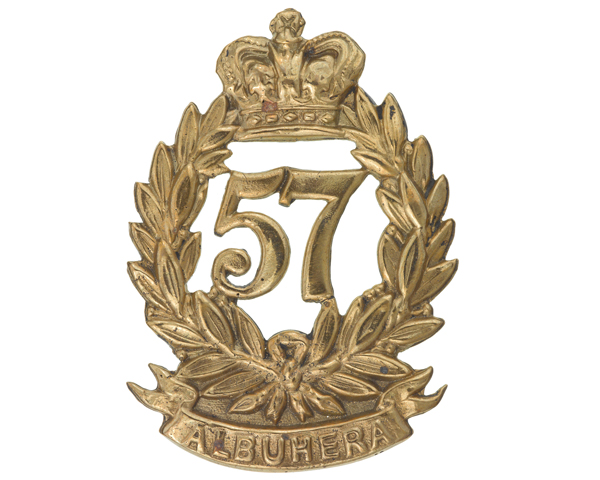Origins
In 1755, a new regiment of foot was raised. Initially numbered 59, this rose to 57 a year later when the old 50th and 51st Regiments of Foot were disbanded.
Some accounts suggest that it was formed mainly of Londoners from the Middlesex Militia. Others suggest it was formed by joining recruits from Manchester, Somerset and Gloucester with two companies from the 3rd and 20th Regiments of Foot.
The regiment’s first posting was to Gibraltar during the Seven Years War (1756-63), from where it operated for a time as marines along the coast of Spain. It was moved to Minorca in 1763 and then to Ireland five years later.
American and French wars
Its next deployment was to the American War of Independence (1775-83), where it fought at Long Island (1776) and Forts Clinton and Montgomery (1777). Most of the regiment served throughout the conflict, but its light company was captured at Yorktown (1781) and interned until the end of the war.
In 1782, the regiment was given a county association with West Middlesex. Then, a year later, it joined the British garrison at Halifax in Nova Scotia for eight years.
It was recalled to Europe in 1793 to fight in Flanders during the opening campaigns of the French Revolutionary Wars (1793-1802). In 1796, it was sent to the West Indies, helping to take St Lucia (1796) and garrisoning Trinidad for seven years.
In 1803, now back in Britain, the regiment raised a 2nd Battalion as part of the Army of Reserve. This remained in England and Jersey until being disbanded soon after Waterloo (1815).
The 1st Battalion returned to Gibraltar for five years in 1804, before being sent to Lisbon.
Peninsula
The regiment’s 1st Battalion suffered heavily in the opening years of the Peninsular War (1808-14), most notably at Albuera (1811), where 88 per cent of its officers and 75 per cent of its men were killed or wounded.
Within a month, its few remaining men were joined with survivors from the 3rd, 29th, 31st and 66th Foot to form the Provisional Battalion.
However, in August 1811, a draft from the 57th’s 2nd Battalion arrived in Spain and was immediately used to re-form the regiment’s 1st Battalion. This fought at Vitoria (1813), Nivelle (1813) and the Nive (1813). By May 1814, it had battled its way to Bordeaux.
It was shipped from there to man the Canadian frontier in the War of 1812 (1812-15), only to sail back the following year. It landed at Ghent in August 1815 and spent two years in France with the Army of Occupation.
Quiz
Which of the following was a nickname of the 57th Regiment?
At the Battle of Albuera in 1811, the 57th came under heavy French attack. Their wounded commander, Lieutenant-Colonel William Inglis, rallied his men with the words 'Die hard, 57th, die hard'. A counter-attack saved the day and the French were eventually defeated. From that day on, the 57th were known as 'The Die-hards'.
19th century
From 1818, it spent six years in Ireland. It then joined convict ships at Chatham and sailed with them to New South Wales. The regiment remained in Australia until 1831, when it moved to India. That posting lasted 15 years and was followed by seven more years in Ireland.
It served throughout the Crimean War (1854-56), fighting at Inkerman (1854) and Sevastopol (1855). It then left two companies behind in Aden in 1857, en route to fighting during the Indian Mutiny (1857-59).
It arrived in India in 1858, but only stayed two years this time. This posting was immediately followed by seven years in New Zealand, including service in the Second Taranaki War (1863-66).
From 1867, it garrisoned Britain, Ireland and Ceylon (now Sri Lanka). Then, in 1879, it sailed to the Zulu War (1879).
Legacy
In 1881, it was merged with the 77th (East Middlesex) Regiment of Foot (The Duke of Cambridge's Own) to form The Duke of Cambridge’s Own (Middlesex Regiment).














